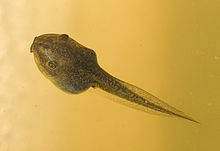en
names in breadcrumbs


The most notable mammal present is the endemic Kangaroo Island Kangaroo (Macropus fuliginosus fuliginosus), the icon for whom the island was named upon European discovery in 1802. A smaller marsupial present on the island is the Tammar Wallaby (Macropus eugenii). An endemic dasyurid is the Critically Endangered Kangaroo Island Dunnart (Sminthopsis aitkeni), which is found only in the west of the island in Eucalyptus remota/E. cosmophylla open low mallee, E. baxteri low woodland or E. baxteri/E. remota low open woodland. The Common Brush-tailed Possum (Trichosurus vulpecula) is a widespread folivore native to Australia.
Monotremes are also represented on the island. There is also an introduced population of the Duck-billed Platypus (Ornithorhynchus anatinus) in the western part of the island in Flinders Chase National Park. The Short-beaked Echidna (Tachyglossus aculeatus) is also found moderately widespread on Kangaroo Island.
Chiroptera species on Kangaroo Island include the Yellow-bellied Pouched Bat (Saccolaimus flaviventris), which species is rather widespread in Australia and also occurs in Papua New Guinea. Australia's largest molossid, the White-striped Free-tail Bat (Tadarida australis) is found on Kangaroo Island. Another bat found on the island is the Southern Forest Bat (Eptesicus regulus), a species endemic to southern Australia (including Tasmania).
Several anuran species are found on Kangaroo island: Brown Tree Frog (Litoria ewingii), Spotted Marsh Frog (Limnodynastes tasmaniensis), Painted Spadefoot Frog (Neobatrachus pictus), Brown Toadlet (Pseudophryne bibroni) and Brown Froglet (Crinia signifera).
The Heath Monitor (Varanus rosenbergi ) is a lizard that grows up to a metre in length, preying on smaller reptiles, juvenile birds and eggs; it is frequently observed on warmer days basking in the sunlight or scavenging on roadkill. The Black Tiger Snake (Notechis ater) is found on Kangaroo Island. Another reptile particularly associated with this locale is the Kangaroo Island Copperhead (Austrelaps labialis).
The Glossy Black Cockatoo (Calyptorhynchus lathami) is found on the island, especially in the western part, where its preferred food, fruit of the Drooping Sheoak, is abundant. The Kangaroo Island Emu (Dromaius baudinianus) became extinct during the 1820s from over-hunting and habitat destruction due to burning.
Marine mammals that are observed on the island include the Australian Sea Lion (Neophoca cinerea) and New Zealand Fur Seal (Arctocephalus forsteri), each species of which is native to Kangaroo Island, and abundant at Admiral's Arch as well as at Seal Bay.
Kangaroo Island is not so adversely impacted by alien species grazers as parts of the mainland. No rabbit species are present on the island, and introduced (but escaped) Domestic Goats (Capra hircus) and pigs (Sus scrofa) have generated only minor issues. However, a Koala (Phascolarctos cinereus) population introduced to the island in the 1920s has caused significant damage to certain woodland communities, especially to Manna Gum trees.
The southern brown tree frog (Litoria ewingii), also known as the brown tree frog, whistling tree frog, or Ewing's tree frog,[2] is a species of tree frog native to Australia: most of southern Victoria, eastern South Australia, southern New South Wales from about Ulladulla—although this species is reported to occur further north—and throughout Tasmania including the Bass Strait Islands, in which state it is the most frequently encountered frog. It has been introduced to New Zealand, where it can be locally abundant.
The southern brown tree frog was described in 1841 by French naturalists André Duméril and Gabriel Bibron.
L. ewingi is one of the classic examples of speciation by reinforcement. Future research into congener hybridisation and gene flow may find such occurring, and may find countervailing reinforcement mechanisms at work.[3]
This species reaches 45 millimetres (1.8 in) in length. It is pale to dark brown on the dorsal surface, with a broad darker patch starting at the eyes and covering the majority of the back, although pure green and green striped colour morphs are also common. A dark band starting at the nostril runs across the eye and tympanum to the shoulder, and a pale white stripe below this runs from the mouth to the arm. The backs of the thighs are orange, and no black marbling is present (except specimens from the Adelaide region), distinguishing this species from the similar whistling tree frog, (Litoria verreauxii). Some specimens from western Victoria and south eastern South Australia can be partially or entirely green. The belly is cream.
This species is found in a wide range of habitats, including forests, farmland, heathland, semiarid areas, alpine regions, and suburban areas. They are particularly common in parts of suburban Adelaide, Melbourne, and Hobart, where they are often observed upon window panes at night, attracted by flying insects. Males make a whistling weep-weep-weep call from beside or floating in the water of, dam impoundments, ditches, ponds, and stream-side pools. Males call all year round, particularly after rain. Eggs are easily identifiable, being wound around submerged grass stems, aquatic vegetation, and sticks. These frogs can freeze and survive although freezing is likely costly for the species.[4]
In Australia, this animal may be kept without any wildlife license when purchased from a breeder. Litoria ewingi does not require any UV supplementation, it simply requires a light cycle and a small water source as it is an arboreal species. However, this species is commonly active during daylight hours, despite being considered primarily nocturnal and crepuscular. Therefore, UV supplementation will likely contribute to providing a quality habitat and healthier, happier frogs.
 Tadpole
Tadpole  In eastern Victoria
In eastern Victoria The southern brown tree frog (Litoria ewingii), also known as the brown tree frog, whistling tree frog, or Ewing's tree frog, is a species of tree frog native to Australia: most of southern Victoria, eastern South Australia, southern New South Wales from about Ulladulla—although this species is reported to occur further north—and throughout Tasmania including the Bass Strait Islands, in which state it is the most frequently encountered frog. It has been introduced to New Zealand, where it can be locally abundant.